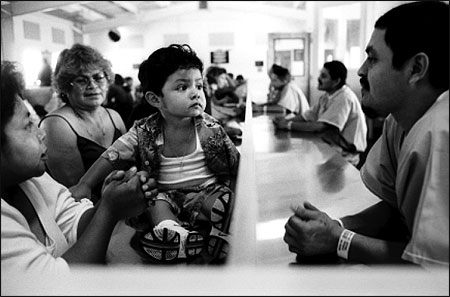 Facing imminent deportation back to his native Guatemala for a criminal conviction, Ronald Zetino is visited by his young son and family. The Mira Loma jail is rare in that it allows visiting families to sit this close to their detained loved ones without being further separated by security glass. Photo by Steven Rubin.
Facing imminent deportation back to his native Guatemala for a criminal conviction, Ronald Zetino is visited by his young son and family. The Mira Loma jail is rare in that it allows visiting families to sit this close to their detained loved ones without being further separated by security glass. Photo by Steven Rubin.After his Nieman year in 1999, freelance photographer Steven Rubin, who lives near Washington, D.C., became aware of the plight of asylum seekers and other immigrants detained by the Immigration and Naturalization Service. He felt strongly that visual documentation was lacking and wanted to use his camera to bring their stories to public attention. Rubin received a Media Fellowship from the Open Society Institute to photograph immigrants held at INS detention centers and county jails across the country beginning in early 2001. In this issue, he shares part of his visual project and tells us about the work involved.
The images I took highlight the lives of those held in detention. They also document the impact this detention has on family members. These photographs focus our attention on compelling stories of injustice and convey some of the disturbing, even un-American truths about immigrant detention both pre- and post-September 11, 2001.
On my journey, I photographed asylum seekers who fled persecution abroad only to be greeted by lengthy detention, unaccompanied minors imprisoned with adults, indefinite detainees or “lifers” who cannot be deported and yet are not released, and long-time legal permanent residents facing deportation to their country of origin, a place many have not known since childhood.
The photographs published in Nieman Reports capture moments in the lives of but a few of an estimated 200,000 to 250,000 immigrants detained by the INS each year. What these images do is begin to put a face on the staggeringly large numbers and help make their situations less deniable, more real. Ultimately, they challenge Attorney General John Ashcroft’s insistence that concerns about the degradation of civil liberties serve only to support terrorists and are but empty protests over “phantoms of lost liberty.”
Outside cameras are rarely if ever allowed inside where most INS detainees are held. My entrance required lengthy, repeated and often futile negotiations with the INS or county jails. Occasionally, I’d be dealing with both bureaucratic layers simultaneously. When permitted, access was typically restricted to a small room normally used for attorney-client meetings within a detention facility. Typically, the room would have white walls, a desk, two chairs, and offer no hint that we were sitting in a detention center or jail.
Working under such restrictions presented many challenges, not the least of which was the difficulty posed in “documenting” detainees in this decontextualized environment. On occasion, my short leash would be stretched a little, allowing a slightly expanded view of detainee life beyond the interview room. But the leash was never fully removed. While the difficulties and frustrations I faced in gaining access to INS facilities with a camera were many, the testimonies I encountered once inside reminded me that no matter how difficult it was for me to get inside, it was always more difficult for detainees to get out. As a photojournalist I feel a deep commitment to harness photography’s power in drawing public attention to their stories.
The following anecdote reflects the grim reality I witnessed. Toward the end of a long day spent interviewing and photographing male detainees at the San Pedro facility in Southern California, I spoke to a young detainee from Cambodia. He had arrived in this country as a refugee at the age of five with his entire family. Now in his mid-20’s, he had grown up in America, gone to school here, and got into trouble with the law in a gang-related offense. He was a legal permanent resident who never applied for citizenship and as a result now faced deportation to a land he can barely remember. Turning to me, he quietly asked if I knew what INS stood for.
“Yes,” I responded, thinking I was being helpful, “the INS means the Immigration and Naturalization Service.” He then shook his head in disagreement and softly but confidently replied no.
“What do you mean by no?” I asked.
“No. That’s not what it means,” he said.
Thinking that he misunderstood me, I restated the spelled-out version of this well-known acronym, this time more slowly and with exaggerated enunciation the way people tend to talk to non-snative English speakers.
He shook his head again more emphatically.
“So what then does the INS mean?” I asked him.
“I’m not sure,” he said, looking me straight in the eye.
“You’re not sure?”
“That’s right, I’m not sure” he replied with an odd smile.
“You’re not sure?” I mimicked.
In response his head started to nod in agreement as he repeated, “I’m not sure. I’m not sure.”
I was puzzled, more than a little annoyed, and fearful that my annoyance was starting to show. At this point, he helped me understand his grim humor by role-playing questions he repeatedly asks INS authorities and their responses. “How much longer will I be detained?” “I’m not sure.” “When will I get to see my lawyer?” “I’m not sure.” “I’ve filed four requests to be seen by the doctor, when will I get an appointment?” “I’m not sure.” “When will I see the deportation officer? Go before the immigration judge? Be released? When will they fix the phones? Will they deport me back to Cambodia, a country I haven’t known since I was five?” Each time the same answer from the same authoritative-sounding source reveals nothing. “I’m not sure.”
In a few short moments, this man offered me a profound insight about what it’s like to be caught in the INS abyss. This isn’t a semantic game. For those held in detention, INS stands for “I’m Not Sure.” This is what it’s like to be detained indefinitely by the INS, confined to an uncertain future in a poorly managed system with few rights and fewer still that are enforced. Being detained by the INS means living in a limbo where little is known, answers are few, and nothing is certain except the tedium of daily life. Try navigating through this convoluted system. Try making sense of immigration law without a lawyer (something an estimated 90 percent of detainees must do). Try doing this while facing deportation, and the picture sharpens into a clearer focus of what it’s like.
As this young man’s message sinks in, his questions make me think of mine that emerge as I travel to these places. When will the INS be truly reformed? When will it stop detaining asylum seekers? When will it no longer lock up children? When will its treatment of immigrants be more consistent with American values and its practices more in accordance with international law? When will the huge processing backlog be eliminated? When will its dysfunctional and bureaucratic ineptness be a thing of the past? When will security concerns no longer dictate immigration policy?
To each of these questions must come the response, I’m not sure. But what I am quite certain about is that it won’t happen anytime soon.
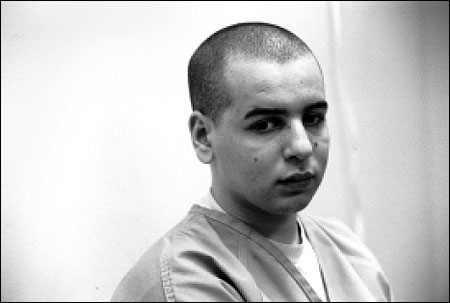 Mohamed Boukrage was 10 years old when a car bomb in Algeria killed his parents and sister. According to his testimony, Mohamed eventually made his way to France, then Italy, where he spent four years doing odd jobs and living in abandoned buildings. When he got word that the Italian police were deporting undocumented immigrants, he hid on a cargo ship that arrived luckily, or so he thought, in the United States.
Mohamed Boukrage was 10 years old when a car bomb in Algeria killed his parents and sister. According to his testimony, Mohamed eventually made his way to France, then Italy, where he spent four years doing odd jobs and living in abandoned buildings. When he got word that the Italian police were deporting undocumented immigrants, he hid on a cargo ship that arrived luckily, or so he thought, in the United States. Mohamed arrived in New York in October 2000 and sought asylum. Immigration authorities did not believe him when he told them he was 16, and they subjected him to a dental examination and wrist x-ray to determine his age. On the basis of these controversial
tests, the INS declared Mohamed was at least 18 years old and brought him to an adult prison, the Elizabeth Detention Center, just south of New York City.
“They said they were taking me to a hotel and then they brought me right here,” Mohamed said, speaking through an interpreter. “They handcuffed me and treated me like a criminal. I feel I’m being punished for no reason.”
His asylum application was denied in 2001 and then denied again on appeal in 2002. Other attempts to free him from detention by his pro bono lawyer were denied by the courts. Unable to deport him back to Algeria since he has no papers, the INS deported him to Italy in July 2002, after 21 months in detention. —S.R.
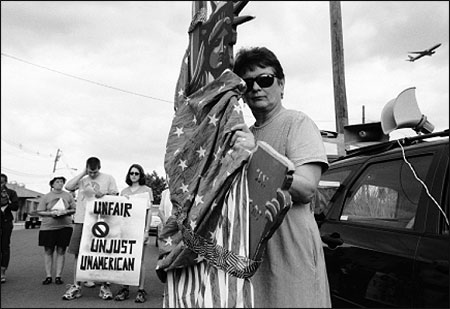
Vigil against INS detention policies outside Elizabeth Detention Center in Elizabeth, New Jersey. —S.R.
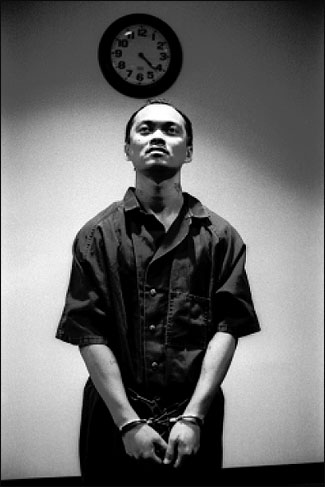
Phoutone Chanthabouala has been detained by the Immigration and Naturalization Service since April 1998. Phoutone came to the United States in 1981with his family when he was nine years old. All refugees from Laos, his entire family arrived in San Francisco; later they moved to Illinois and ultimately settled in Arkansas. In Arkansas, Phoutone got into trouble with the law and served approximately three years’ jail time until he was paroled in 1997. On a visit to his parole officer in 1998 the INS took him into custody and has held him ever since.
The INS picked him up with the intent of deporting him back to Laos, a country he has not known since he was a child. Laos lacks sufficient diplomatic relations with the United States and as a result does not accept the return of INS detainees. The INS cannot then deport him and will not release him, and so he sits in detention indefinitely, waiting for years on end.
He was photographed at the Oakdale Detention Center in Oakdale, Louisiana, but is normally detained in the Iberia Parish Jail in in rural Louisiana. —S.R.
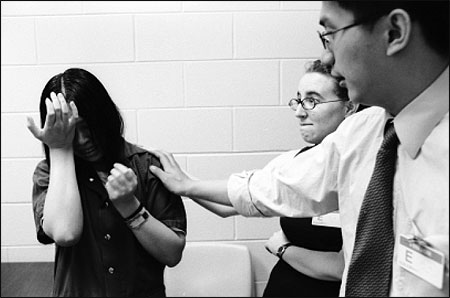
After nearly 18 months in detention, Hua Zhen Chen learns from her lawyers that her next asylum hearing before the immigration judge will not occur for another four months. Having ignored three previous requests for parole and denied another, the INS appeared resolved to keep her locked up in Virginia jails at least through the court date. But due in part to the tireless efforts of the Washington, D.C.-based Capital Area Imigrants’ Rights Coalition and the work of her student lawyers from American University Law School, Chen was finally released on bail two months later. —S.R.
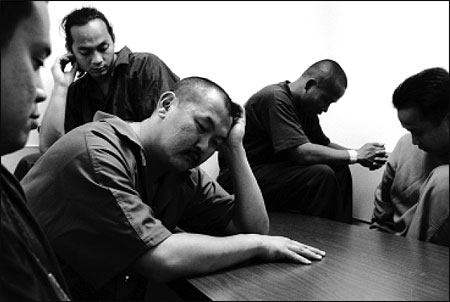
Detained immigrants at an INS facility in San Pedro, California face deportation to home countries they left as young children. Those pictured are from the countries of Vietnam, Laos and Cambodia, all places that lack sufficient diplomatic relations with the United States and as a result do not accept the return of INS detainees. The INS cannot deport them and won’t release them. So they remain in detention indefinitely. Hence their name, indefinite detainees or “lifers.” —S.R.
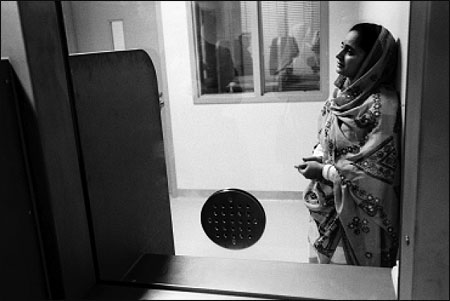
Farhana, a young Pakistani Muslim woman, came to the United States in September 2000 fearing for her life. Because her family believed that she had shamed them, they beat her, confined her, and threatened her with “honor killing.” Determined to flee Pakistan but with no hope of obtaining proper identification and travel documents on her own, Farhana turned to unscrupulous smugglers who provided her with false documents and an airline ticket to the United States and advised her to file a false application for asylum upon her arrival. When she attempted to enter the country using the false documents, the INS detained her.
Following the smugglers’ instructions, Farhana made a false application for asylum in the immigration court. But before the judge ruled on her case, she recanted the false claim and made a new application for asylum in the court based on her true circumstances. In September 2001, following a prolonged and complicated asylum hearing, the immigration judge denied Farhana’s asylum application, finding that she was disqualified from asylum due to her earlier false application. Nonetheless, the judge was convinced that Farhana
would be persecuted if she were returned to Pakistan and granted her application for withholding of removal.
At this point, the INS continued to detain Farhana at the Wicomico County Detention Center in Maryland. The events of September 11 further complicated her custody situation: Shortly after the attacks the FBI questioned her several times at length, and the INS chose to appeal the judge’s ruling. Finally this spring, after more than 18 months in detention, the Board of Immigration Appeals upheld the INS’s appeal of the judge’s grant of withholding of removal, dismissed an appeal of the judge’s denial of asylum, and ordered Farhana deported to Pakistan. She was deported in June 2002. A Pakistani interpreter who assisted her lawyer on the case recently expressed that he does not expect Farhana to live more than six months after returning there. —S.R.
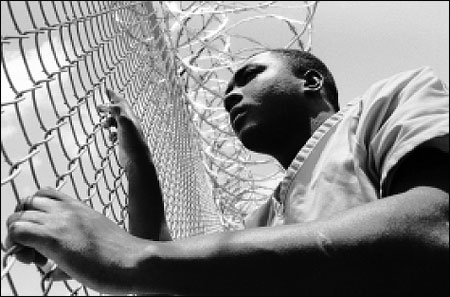
Juan Belalcazar, a 23-year-old asylum seeker from Colombia, stands beside the razor wire lined fence at Krome Service Processing Center, an INS detention facility in Miami, Florida where he has been held for seven months. According to an account, Belalcazar fled the political violence in his country after witnessing an assassination and then being threatened. He escaped to Panama by boat, traveled to Guatemala on foot, trucks and buses, and then traveled as a stowaway in a ship to Louisiana. Upon his arrival he was deported by the INS back to Colombia. Upon his return to Colombia he immediately traveled again to Panama and then on to Guatemala, whereupon he traveled yet again as a stowaway, this time arriving in Miami. He applied for asylum in Miami and was immediately taken into detention at the Krome facility. Belalcazar’s application for asylum was denied and is now on appeal. The INS refuses to release him while his case is on appeal, even though he has committed no crime. Speaking in his native spanish, Belalcazar said, “They say this is the land of liberty, but ...” shaking his head, “I don’t find any liberty.” —S.R.
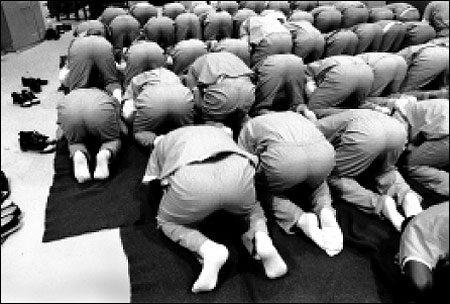 Muslim detainees during Friday prayer at Elizabeth Detention Center in Elizabeth, New Jersey. —S.R.
Muslim detainees during Friday prayer at Elizabeth Detention Center in Elizabeth, New Jersey. —S.R.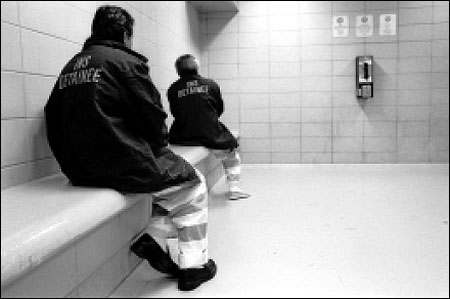
Pakistani and Mexican detainees, who are facing deportation, wait inside a holding cell before being escorted upstairs to their immigration hearings. Woken up in the middle of the night, they were transported several hours by van to make the morning docket in Baltimore. Neither man had any legal representation. The jackets and striped uniforms are standard issue at their place of detention, Wicomico County Jail on the Eastern Shore of Maryland, and are used to distinguish INS detainees from other prisoners held there. Their only contact with the outside world, a pay telephone, can be used to make collect or calling card calls at frequently exorbitant rates. —S.R.



